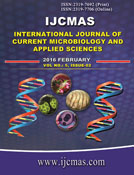


 National Academy of Agricultural Sciences (NAAS)
National Academy of Agricultural Sciences (NAAS)

|
PRINT ISSN : 2319-7692
Online ISSN : 2319-7706 Issues : 12 per year Publisher : Excellent Publishers Email : editorijcmas@gmail.com / submit@ijcmas.com Editor-in-chief: Dr.M.Prakash Index Copernicus ICV 2018: 95.39 NAAS RATING 2020: 5.38 |
The field experiment was conducted during kharif (rainy) seasons of 2011 and 2012 at Regional Agricultural Research Station, Lam, Guntur, India in randomized block design with three replications to study the response of integrated weed management (IWM) practices on growth and yield of pigeonpea. The weed free treatment significantly decreased the weed density, dry weight of weeds and also increased in weed control efficiency compared with weedy check. Integration of one hand weeding/intercultivation at 50 DAS with application of imazathapyr @ 75 g a.i./ha at 10-15 DAS+quizalofop-ethyl @50g a.i./ha proved effective in reducing total weed density and dry weights of weeds and also increased in weed control efficiency compared with weedy check. The maximum values of growth parameters, yield attributes and yield (1934 kg/ha) were recorded under weed free situation but it was significantly superior over all other treatments. Among the IWM practices, application of imazethapyr @75g a.i./ha at 10-15 DAS+ quizalofop-ethyl @50g a.i./ha at 15 DAS followed by one hand weeding/intercultivation at 50 DAS resulted the maximum yield (1707 kg/ha) which was closely followed by application of Pendimethalin @ 0.75g a.i./ha PE+ Imazethapyr @ 60 g a.i./ha POE at 15 DAS (1509kg/ha) than weedy check (949 kg/ha). Beneficial effect due to above treatments on growth characters resulted in enhanced grain yields of pigeonpea.
 |
 |
 |
 |
 |